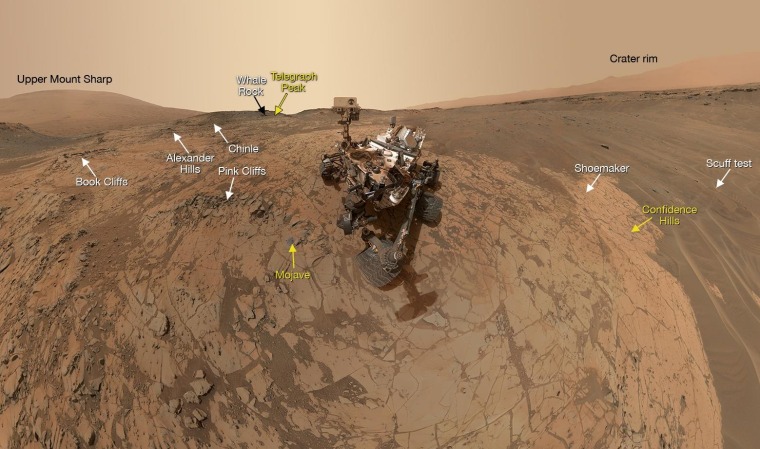The latest selfie from NASA's Curiosity rover isn't just a vanity shot — it serves as a guide to the Martian locale where it's been working for the past five months.
Two and a half years into its Mars mission, the six-wheeled, nuclear-powered robot is exploring Pahrump Hills, an outcrop at the base of 3-mile-high (5-kilometer-high) Mount Sharp, also known as Aeolis Mons. It's now getting ready to drill into bedrock at a site called Telegraph Peak.
This mosaic, assembled from dozens of images captured by a camera at the end of the rover's robotic arm, is centered on an earlier drilling spot called Mojave 2. An annotated version of the super-wide-angle panorama shows the rover in relation to Telegraph Peak as well as the top of Mount Sharp and the rim of Gale Crater.

Curiosity has taken similar selfies in the course of its 6.4-mile (10.3-kilometer) trek through the crater.
"We added extra frames for this one so we could see the rover in the context of the full Pahrump Hills campaign," rover team member Kathryn Stack, a researcher at NASA's Jet Propulsion Laboratory, said Tuesday in a news release. "From the Mojave site, we could include every stop we've made during the campaign."
The rock samples from Mojave, Telegraph Peak and elsewhere will be analyzed to trace Pahrump Hills' geological history — and flesh out the story of ancient Mars' potentially habitable environments.
The rover took the pictures that went into the all-around view last month, by extending its robotic arm and turning the Mars Hand Lens Imager, or MAHLI, toward itself and the surrounding terrain. For that reason, the arm itself doesn't show up in the selfie view — just as your own selfies don't usually show the arm holding the smartphone.